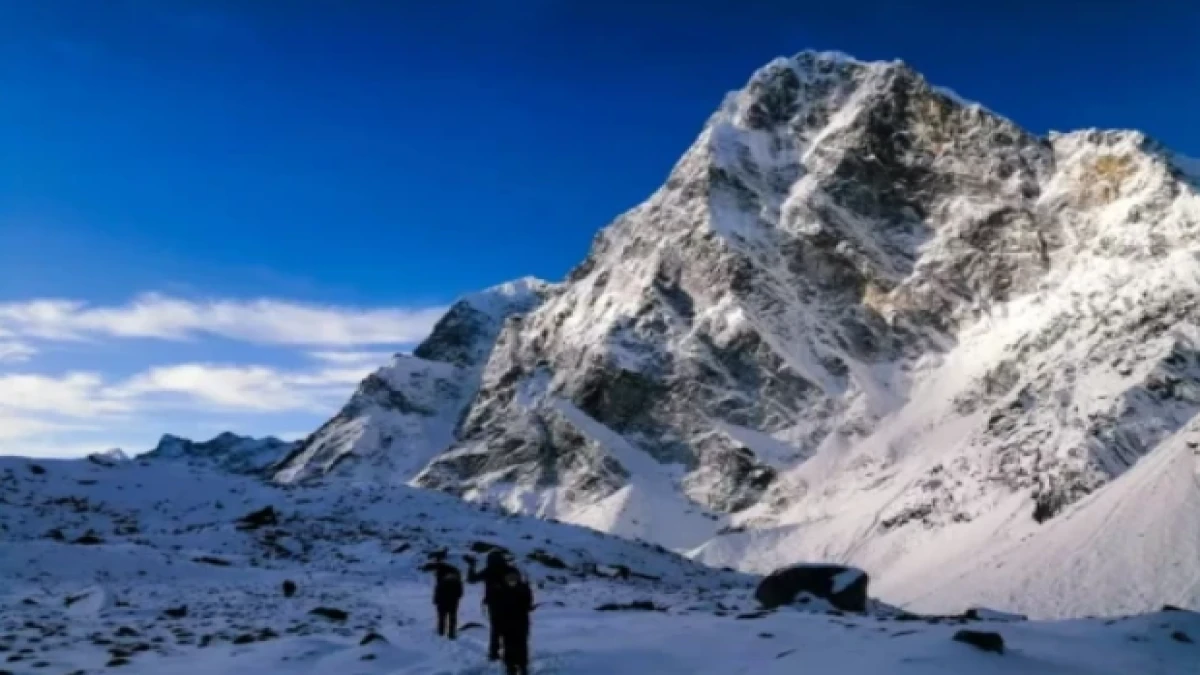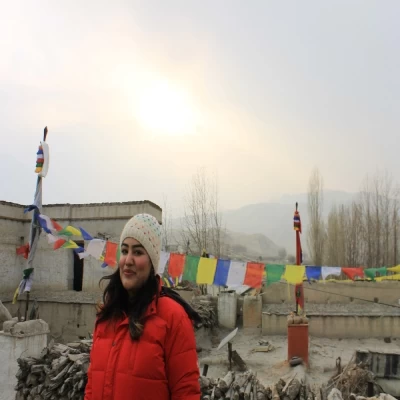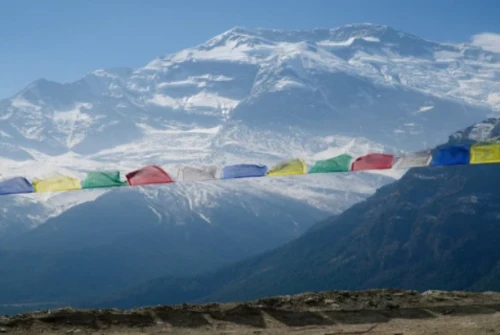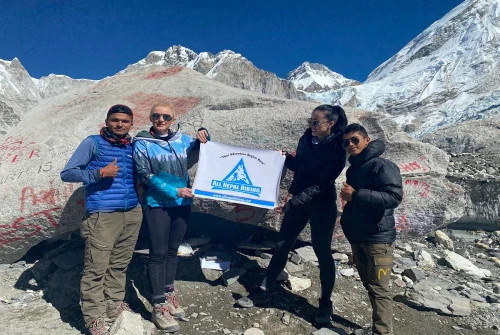The Everest Base Camp trek in spring is more than just a walk through the Himalayas; it is a transformative journey that combines breathtaking natural beauty, cultural richness, and personal achievement. Stretching across 12 to 14 days on average, this trek takes us from the vibrant city of Kathmandu to the heart of the Khumbu region, where every step reveals a new layer of wonder. Spring, between March and May, offers the most favorable conditions, making it the perfect season to undertake this world-renowned adventure.
The trek begins with a thrilling flight into Lukla, a small mountain town perched high above the valleys. From here, the trail winds through charming Sherpa villages, suspension bridges draped with prayer flags, and forests alive with blooming rhododendrons. Each day brings us closer to the legendary Base Camp, but the journey is just as important as the destination. Along the way, we explore bustling towns like Namche Bazaar, the cultural and commercial hub of the Khumbu, and serene monasteries like Tengboche, where the sound of Buddhist chants blends with the backdrop of towering peaks.
One of the defining features of trekking in spring is the clarity of the mountain views. The sky remains crisp and blue, unveiling snow-clad giants like Everest, Lhotse, Nuptse, and Ama Dablam in all their glory. The blooming landscapes add color and vibrancy, turning the trek into a perfect blend of rugged wilderness and natural beauty. Evenings in cozy teahouses offer warm meals and conversations with fellow trekkers, creating a sense of community that enriches the journey further.
Reaching Everest Base Camp at 5,364 meters is the crowning moment of the trek. Standing on the glacial moraine, surrounded by expedition tents and climbers preparing to scale the world’s tallest mountain, fills us with a sense of awe and accomplishment. The trek doesn’t end here; ascending to Kala Patthar rewards us with the best panoramic view of Everest itself, glowing golden under the rising sun. In spring, this journey becomes a once-in-a-lifetime adventure where every step brings not only physical progress but also a deeper emotional connection with the Himalayas.
Why Choose Spring for the Everest Base Camp Trek?
Spring stands out as the best season to trek to Everest Base Camp because it combines safety, beauty, and comfort. The weather during March, April, and May is far more stable compared to winter and summer. Days are pleasantly warm for trekking, while nights at high altitudes, though still cold, are bearable with proper gear.
Another reason spring is so highly recommended is the visual clarity. Unlike summer monsoon months, the skies are mostly cloudless, giving trekkers uninterrupted views of Everest, Lhotse, Ama Dablam, and surrounding peaks. These postcard-perfect panoramas are one of the main reasons thousands of trekkers plan their trip during this season.
Cultural vibrancy is also at its peak. Sherpa villages like Namche Bazaar, Tengboche, and Pangboche are bustling with activity. From prayer ceremonies in monasteries to local markets filled with goods, trekkers can immerse themselves in the rich traditions of the Khumbu. The season thus offers not only a physical journey but also a cultural and spiritual connection with the Himalayas.
What Is the Weather Like in Spring?
The spring months, March, April, and May, each bring unique trekking conditions, but all three are favorable for Everest Base Camp.
In March, the snow from winter begins to melt, and the trails reopen. While mornings and nights can still be cold, daytime temperatures are comfortable, ranging from 10°C to 15°C at lower altitudes. Trekkers in March enjoy quieter trails compared to later in the season, making them perfect for those seeking a more peaceful trek.
April is considered the peak of the trekking season. It offers the best balance between warm days, clear skies, and manageable nights. Daytime temperatures rise to around 12°C to 18°C, while nights dip to about -5°C at higher altitudes. April is also when rhododendron forests are in full bloom, creating some of the most colorful trekking landscapes in Nepal.
By May, temperatures are warmer, especially at lower elevations, where days can reach 20°C. Nights remain chilly but manageable. However, as the month progresses, clouds and pre-monsoon showers start to appear in the afternoons. Despite this, May is particularly exciting because it coincides with Everest summit season, and trekkers often find Everest Base Camp bustling with mountaineering activity.
Which Scenic Highlights Await in Spring?
Spring trekking to Everest Base Camp guarantees breathtaking landscapes and unique cultural encounters.
The most enchanting highlight is the blooming rhododendron forests. These flowers, Nepal’s national bloom, add splashes of red, pink, and white along the trail, especially between Lukla, Namche, and Tengboche. Walking through these forests with the snow-capped mountains as a backdrop feels surreal.
The mountain views are at their sharpest during spring. Famous viewpoints, such as Tengboche Monastery and Kala Patthar, provide panoramic vistas of Everest and neighboring peaks that remain crystal clear in the crisp spring air. Sunrises and sunsets during this time are especially magical, as the golden hues light up the Himalayan giants.
Another scenic highlight lies in the cultural immersion. Spring is a time when Sherpa communities are active and engaged. From visiting monasteries adorned with prayer flags to joining in local festivals or simply sharing tea with Sherpa families, trekkers gain deep insights into the mountain lifestyle. This balance of nature and culture is what makes spring trekking truly remarkable.
Why Is Spring Trekking Popular Despite the Crowds?
The Everest Base Camp trail in spring attracts thousands of trekkers, making it the busiest trekking season. However, the benefits of trekking alongside others outweigh the challenge of crowded teahouses.
For one, the infrastructure is at its best during spring. Teahouses, lodges, and trails are fully operational, offering hot meals, warm beds, and even added amenities like Wi-Fi or charging facilities. The abundance of open lodges ensures trekkers enjoy better comfort compared to the off-season.
Secondly, the sense of camaraderie among trekkers is one of the joys of spring trekking. Sharing meals, stories, and encouragement with fellow adventurers from all around the world creates memories that go beyond the trail itself. The atmosphere feels like a celebration of global adventure, uniting people through their shared dream of reaching Everest Base Camp.
Finally, the energy at Base Camp itself is electrifying. Seeing mountaineers preparing for Everest expeditions alongside trekkers adds to the thrill, making the journey even more special. Instead of being a drawback, the crowds contribute to the unique vibrancy of spring trekking.
What Are the Challenges of Spring Trekking?
Even in the best season, trekking to Everest Base Camp is not without its challenges.
The first is the risk of altitude sickness. As trekkers ascend beyond 3,000 meters, the chances of developing AMS increase. Symptoms like headaches, dizziness, or nausea can occur if acclimatization is not taken seriously. This is why rest days at Namche Bazaar and Dingboche are essential.
Another challenge is the high demand for services. Flights to Lukla, trekking permits, and lodge accommodations fill up quickly. Trekkers must plan and book in advance to avoid last-minute disappointments.
Lastly, in late May, the approach of the monsoon brings occasional rainfall and cloud cover. While mornings usually remain clear, afternoons may be less predictable. With proper gear—like waterproof jackets and trekking boots—these challenges can be easily managed.
How Should You Prepare for the Trek?
Preparation is the key to enjoying the Everest Base Camp trek in spring.
Physical training is crucial. Building endurance through regular hiking, running, or cycling helps prepare your body for long days on the trail. Strength training, especially for legs and core, ensures stability on rocky paths.
Packing wisely is equally important. Spring requires a layering system, with thermal wear for cold nights, fleece and down jackets for higher elevations, and lighter clothing for warmer days. Don’t forget sun protection—sunglasses, hats, and sunscreen are essential due to strong UV rays at altitude.
Finally, plan for proper acclimatization and hydration. Drinking at least 3–4 liters of water per day, pacing yourself, and eating nutritious meals in teahouses keep your body strong for the journey. With preparation, trekkers can turn challenges into opportunities for growth.
Conclusion
The Everest Base Camp trek in spring is an unparalleled adventure. From colorful rhododendron forests and crystal-clear mountain views to the vibrant spirit of Sherpa culture and the inspiring atmosphere of Everest expeditions, every step is filled with wonder. March offers quieter trails, April presents the perfect balance of weather and scenery, and May delivers the excitement of climbing season. Whichever month you choose, spring ensures that Everest reveals itself in its finest form. For anyone dreaming of standing at the foot of the world’s highest peak, spring is the season that makes the dream unforgettable.




